In today's fast-paced world, where every business is looking for innovative ways to enhance their operations and customer experiences, the role of modern technology cannot be understated. CEOs, CIOs, and CMOs are constantly seeking solutions that offer greater visibility into their systems, improve performance, and help troubleshoot issues swiftly. OpenTelemetry, an open-source project designed to monitor and trace applications, is gaining momentum as a powerful tool for achieving these goals.
However, when considering the adoption of a new technology, one of the first questions that often arises is, "What will it cost?" In this blog post, we will delve into the world of OpenTelemetry, shedding light on its licensing model, understanding what parts are open source, and uncovering any potential costs associated with its usage. By the end of this article, you'll have a comprehensive understanding of the financial aspects of implementing OpenTelemetry within your organization.
The OpenTelemetry Revolution
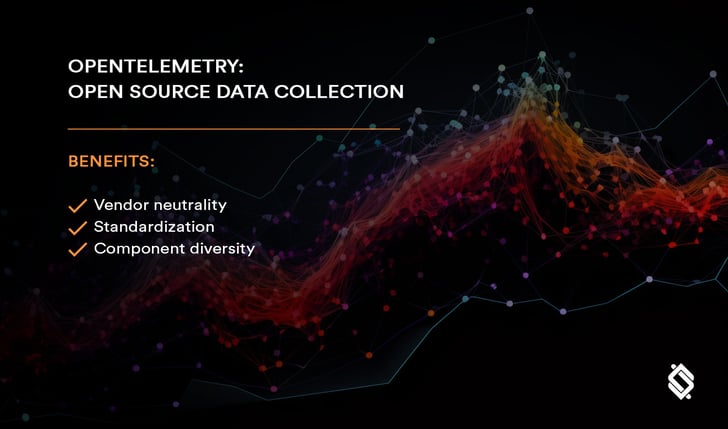
Before we dive into the financial aspects of OpenTelemetry, let's start with the basics. OpenTelemetry is an open-source project that provides a unified framework for collecting observability data across applications, microservices, and infrastructure. This data includes metrics, traces, and logs, which are essential for monitoring and troubleshooting complex systems.
OpenTelemetry is rapidly gaining popularity for several reasons:
- Vendor Neutrality: OpenTelemetry is a vendor-neutral project, supported by the Cloud Native Computing Foundation (CNCF). This neutrality ensures that no single entity controls the project, making it an attractive choice for organizations looking to avoid vendor lock-in.
- Standardization: By providing a standard way to collect and export observability data, OpenTelemetry simplifies the integration of various observability tools. This standardization enhances compatibility and flexibility across your technology stack.
- Rich Ecosystem: OpenTelemetry boasts a rich ecosystem of instrumentation libraries, plugins, and exporters. These components make it easy to monitor a wide range of applications and services, regardless of the programming language or technology used.
Now that we understand the fundamental value of OpenTelemetry, it's time to address the financial aspect.
The Open Source Core: No Cost Attached
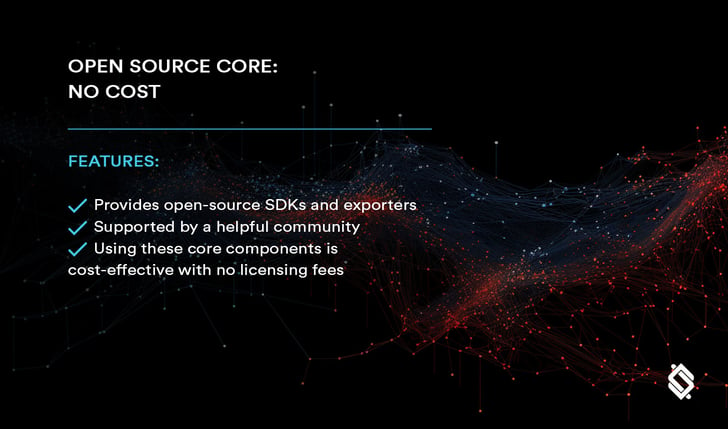
One of the most attractive features of OpenTelemetry is that its core components are open source and completely free to use. This means that you can start integrating OpenTelemetry into your organization's infrastructure without incurring any initial expenses. Let's take a closer look at what you get for free:
- SDKs and Instrumentation Libraries: OpenTelemetry provides software development kits (SDKs) and instrumentation libraries for a wide array of programming languages. These libraries are open source and readily available for you to use. They allow you to instrument your applications to collect metrics and traces seamlessly.
- Exporters: OpenTelemetry offers a variety of exporters that allow you to send the collected observability data to your preferred backends and monitoring tools. Exporters like Jaeger, Zipkin, and Prometheus are open source and come at no additional cost.
- Community Support: The open-source nature of OpenTelemetry means you can leverage a supportive and engaged community for help, advice, and contributions. This community-driven model is valuable for addressing issues and extending the functionality of OpenTelemetry.
In summary, if you intend to use the basic building blocks of OpenTelemetry, you can do so without any licensing fees. This makes it a cost-effective choice for organizations seeking to bolster their observability capabilities without a substantial upfront financial commitment.
Commercial Components: Unveiling the Costs
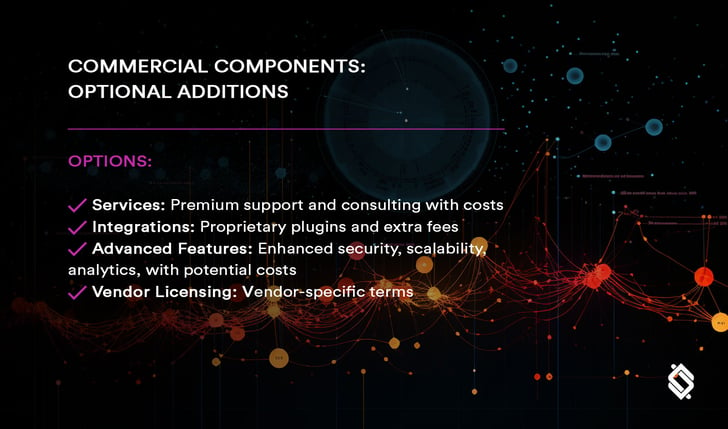
While the core components of OpenTelemetry are open source and free, it's essential to be aware that there are commercial elements associated with OpenTelemetry as well. These components are typically designed for enterprises with advanced observability needs. Let's explore these commercial aspects:
- OpenTelemetry Services: Some organizations may require premium support, training, and consulting services to ensure a smooth adoption and efficient operation of OpenTelemetry. These services are typically provided by specialized vendors and can come with associated costs.
- Enterprise-Grade Integrations: For businesses needing specialized integrations, advanced security features, or support for legacy systems, certain vendors offer proprietary plugins and integrations as part of their commercial packages. These integrations may come with licensing fees.
- Extended Features: Commercial solutions often provide advanced features and capabilities beyond the standard open-source offerings. These can include enhanced security, scalability, and advanced analytics. Depending on your specific needs, these features may involve additional costs.
- Vendor-Specific Licensing: While the core of OpenTelemetry is open source, some vendors might have their own licensing models for components they develop or support. Be sure to carefully review the licensing terms associated with any vendor-specific components.
It's important to note that these commercial components and services are not mandatory for all organizations. Many businesses can effectively leverage the open-source core of OpenTelemetry without the need for additional costs. However, for those seeking more specialized or advanced capabilities, the availability of these commercial options can be a valuable asset.
Evaluating the Costs: Factors to Consider
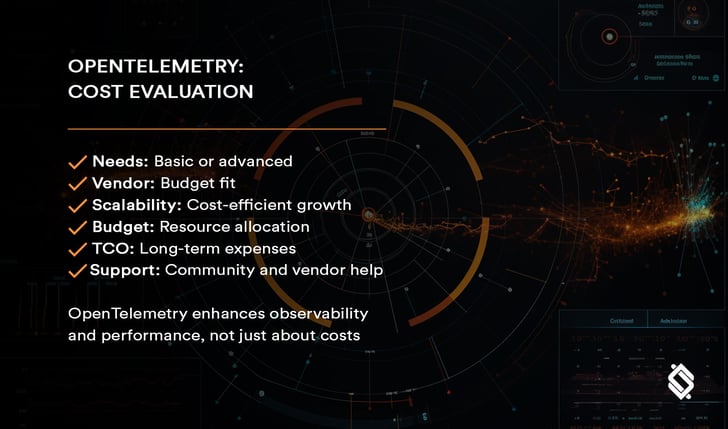
As a CEO, CIO, or CMO, evaluating the costs of adopting OpenTelemetry involves a comprehensive analysis. Here are several factors to consider when assessing the financial implications:
- Organizational Requirements: Start by identifying your organization's specific observability needs. Do you require the basic features provided by the open-source core, or do you need advanced functionality and support?
- Vendor Selection: If you decide to explore commercial options, research and choose a vendor that aligns with your requirements and budget. Different vendors may offer various packages and pricing models.
- Scale and Growth: Consider the scale of your applications and the potential for growth. Ensure that your observability solution can adapt to changing demands without incurring exponential costs.
- Budget Constraints: Assess your budget constraints and allocate resources accordingly. Prioritize the components and services that are critical to your organization's success.
- Total Cost of Ownership (TCO): Look beyond the initial licensing costs and consider the long-term TCO. Factor in expenses related to training, maintenance, and support.
- Community and Vendor Support: Evaluate the level of community support available for open-source components and the quality of vendor support for commercial offerings.
Remember that the decision to adopt OpenTelemetry is not solely a financial one; it also involves enhancing your organization's observability, which can lead to improved system reliability, performance, and customer satisfaction.
Best Practices for Implementing OpenTelemetry
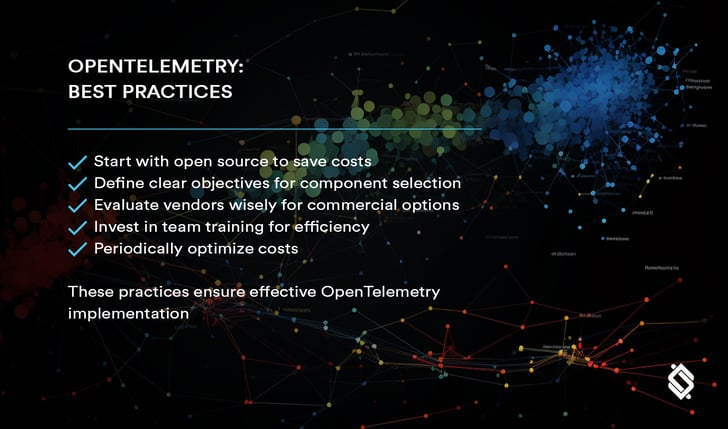
To make the most of OpenTelemetry and minimize potential costs, consider these best practices when implementing this observability framework:
- Start with the Open Source Core: Begin by implementing the open-source components of OpenTelemetry. This will provide you with a solid foundation for observability without incurring any licensing fees.
- Define Clear Objectives: Clearly outline your observability objectives and identify the components and features that are crucial to achieving them. This will help you make informed decisions about commercial components and services.
- Vendor Selection: If you decide to explore commercial options, thoroughly evaluate vendors based on their reputation, support, pricing, and alignment with your needs.
- Invest in Training: Investing in training for your team can maximize the benefits of OpenTelemetry and minimize the time and costs associated with onboarding.
- Regularly Review Costs: Periodically review the costs associated with your observability stack. Ensure that you are optimizing expenses and not paying for unused features.
Conclusion

In the pursuit of improved observability, OpenTelemetry stands as a powerful, open-source solution that can significantly enhance your organization's ability to monitor, troubleshoot, and optimize its systems. While the core components of OpenTelemetry are open source and free to use, it's essential to be aware of the commercial aspects and potential costs associated with specialized services and features.
As a CEO, CIO, or CMO, understanding the cost and licensing model of OpenTelemetry is crucial for making informed decisions about your observability strategy. By considering your organization's unique requirements, budget, and objectives, you can harness the power of OpenTelemetry while managing costs effectively.
In summary, OpenTelemetry's cost-effectiveness, open-source nature, and potential for advanced capabilities make it a valuable addition to your technology stack. With the right approach and careful consideration, you can unlock the full potential of OpenTelemetry while keeping your budget in check.



